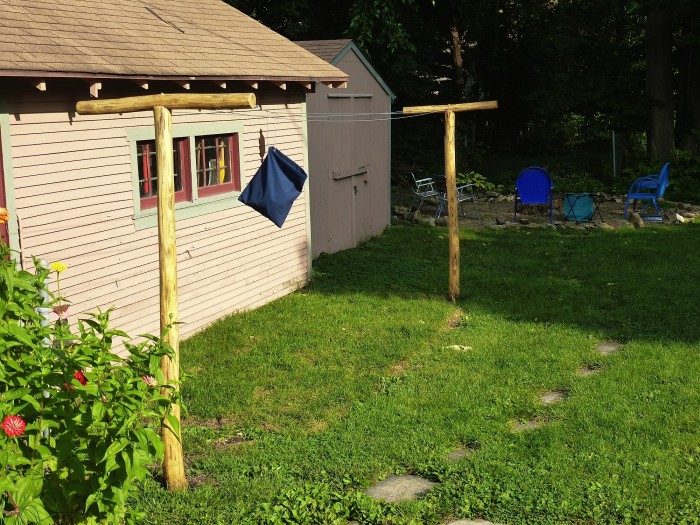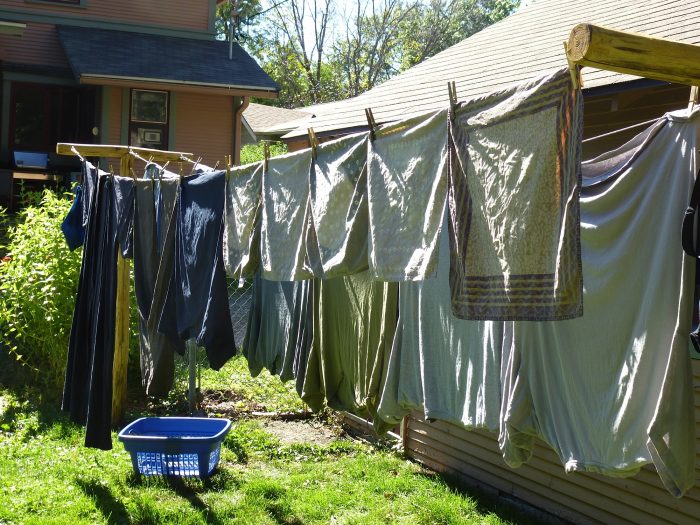Eco Musings: Why I Love My Clothesline

I am ecstatic! Over the moon! Happy as a clam in love with my new clothesline. Nobody in the history of the world has ever been happier with something as mundane.
I’ve tried all kinds of outdoor clotheslines in my 30-plus years of domesticity. Nothing worked as well as I wanted it to. Retractables grew so limp sheets and quilts dragged on the ground. While umbrellas worked for most clothes, their lines were too short and close together to pin sheets and blankets from even one bed. I dreamed of an old fashioned three-line T-post clothesline, like the one from my youth, but couldn’t figure out where to put it and, not being handy, was unable to build one myself.
Cursed with a visual sensibility and a perfectionist temperament, I spent years ruminating, imagining various positions in the yard. Suddenly, it came to me in a flash. Moving a small garden would free up the perfect spot beside the garage, sunny all day and out of the way. At the same time I had the perfect person to build it—Sean Spain, independent owner of Farm Boy Technology–a true find, a craftsman, a problem-solver who shares my aesthetic, enjoys the work, and doesn’t overcharge.
Sean decided to use straight black walnut saplings (a hardwood that will last at least 50 years) which he had previously cut and air dried for two years. He used 5-inch diameter saplings for the posts and roughly 3-inch diameter pieces for the cross bars. He buried the posts 42 inches in the ground below frost level. Above ground they reach a height of 6 ½ feet, tall enough to be overhead but within easy reach to hang clothes. Cross bars are notched to the posts at the joint and held together with 8-inch lag screws drilled through the top.
I didn’t want plastic line (due to eco concerns—plastic is a petroleum product) and cotton would get wet and dirty, so we chose 1/8-inch stainless steel line with turn buckles at the posts to tighten the lines for tautness. An 18-foot expanse between the T-posts mimics the length of garage for visual perspective and is long enough to hang a heaping basket of fresh laundry. Total cost, materials and labor: $250.
I love looking at my new clothesline even when it’s bare—it’s so pretty and natural and efficiently located. Now, on sunny wash days, I can be found barefoot in the grass humming a tune and remembering the old-fashioned wisdom of my grandmother who taught me the unbendable rules for hanging clothes out to dry. Rules—like so much Depression-era thrift and frugality—that are largely forgotten in today’s era of electrical conveniences that cost money to operate and add greatly to our planet’s carbon burden.
Grandma’s Rules for Hanging Clothes Out to Dry
My grandmother took homemaking seriously. For her, hanging laundry on the line was more than a wash day chore. It was testament to her talents and abilities, as well as insight into her private life for all the neighbors to view and critique. She had her rules, and they were these:
(1) First, wipe the line with a damp cloth so it’s clean.
(2) Always hang whites with whites and hang them first.
(3) Hang socks by the toes, not the tops.
(4) Hang pants by the cuffs, not the waistband.
(5) Put sheets and towels on the outside lines to hide undies and unmentionables from public view.
(6) Never hang a shirt by the shoulders, always by the tail.
(7) Use clothespins efficiently—each item sharing a pin with the item next to it.
Did You Know…?
A clotheslines can save you money. Electric dryers account for 5 to 10% of residential energy use.
Clothes and sheets smell like fresh air and sunshine when hung outside to dry.
When conditions are right, it takes half the time (or less) to dry clothes outside than in a clothes dryer.
Fabrics last longer when air dried.
Sunshine is a natural disinfectant.




October 28th, 2014 at 10:44 pm
[…] First published: https://greencleaningmag.com/eco-musings-why-i-love-my-clothesline/ […]